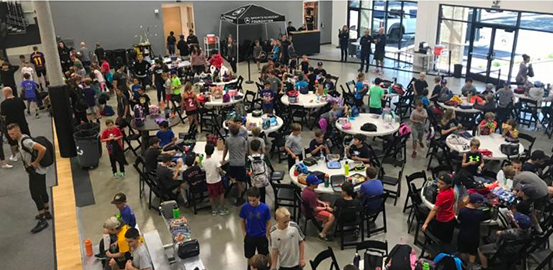A few days after the devastating Woolsey fire erupted in Malibu, and with school cancelled for the following two weeks, 378 kids spent the day happily engaged in sports and other activities at a free pop-up community center that had been quickly organized by a Community Partners project called 805Help. The next day saw 690 students come through the doors. As of this writing, more than 700 were expected.
“It’s just a beautiful thing,” marveled Emily Barany, the powerhouse behind the effort, which was started last year in response to the Thomas Fire. Knowing parents would need to tend to the trauma wrought by the fires, Barany and her small staff teamed up with The Sports Academy in Thousand Oaks, mobilized up to 100 volunteers to staff the venture, and facilitated the donation of food and snacks for all.
It was a stellar example of how a small, nimble organization could quickly and effectively help respond to a post-disaster need that might have otherwise gone unmet. Larger organizations expertly address critical large-scale emergency-response efforts, like providing shelter to tens of thousands of survivors, offering medical aid, or providing basic supplies. But, as Barany recognized following last year’s Thomas Fire, they can’t really harness that grassroots goodwill that springs to life following a disaster.
Last fall, the day after the Thomas Fire broke out in Ventura County, Barany tried donating items at a location she read about on Facebook. When she was turned away, she felt frustrated by her desire to be of service and figured others had probably felt the same. “Not only was it inefficient, but willing donors were being turned away, and lost.”
Barany got together with a friend and launched the Thomas Fire Help Fund. A self-described serial entrepreneur whose own business, Visionality, provides back-office services to nonprofits, she thought the project would be a good match for her skillset. She also knew to not start her own nonprofit. “Why would I do that when I know that by working with you all (through fiscal sponsorship) more of the money I raise will go to helping people, rather than to unnecessary overhead?”
That help has included getting Wi-Fi hotspots up and running when service was cut off to a swath of the affected areas by enlisting help from a couple of local residents who made their properties available for an emergency solution. And after the Thomas Fire, they recruited pilots who volunteered to transport medical personnel and critical need patients by air when roads were cut off by the Montecito mudslides.
With Ventura County and nearby Malibu and Thousand Oaks experiencing a total of six disasters in the past 11 months, the project recently re-branded as 805Help, to continue to support survivors. Via their website, they work to connect those in need with those who want to help.
“We’re staying focused on grassroots efforts and working to connect those who want to help with those who need support,” she explained. “As an example, there’s a whole community in San Diego who want to support my neighbors here. This is a way for strangers to become neighbors through disaster recovery.”
You can support 805Help here. Barany also recommends the Ventura County Community Foundation, which has two funds established to help nonprofits serving fire survivors as well as one for the Borderline tragedy.
A helpful resource to share once rebuilding and recovery gets underway is “From Chaos to Community: A Guide to Helping Friends and Neighbors Recover and Rebuild After a Major Disaster” from Community Partners.





